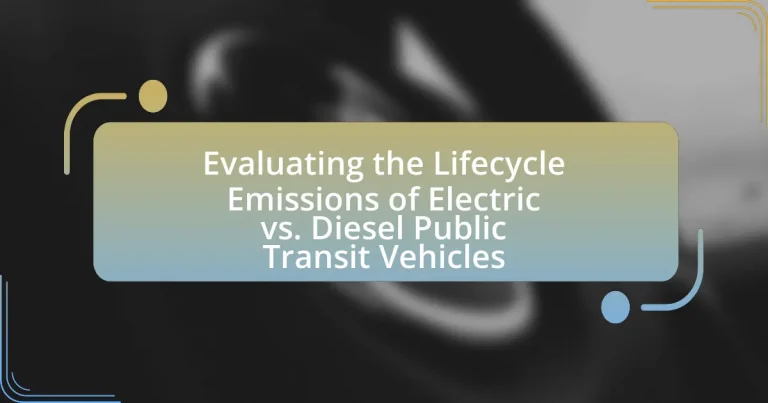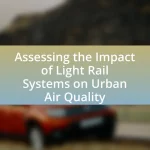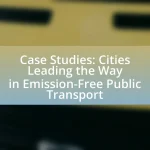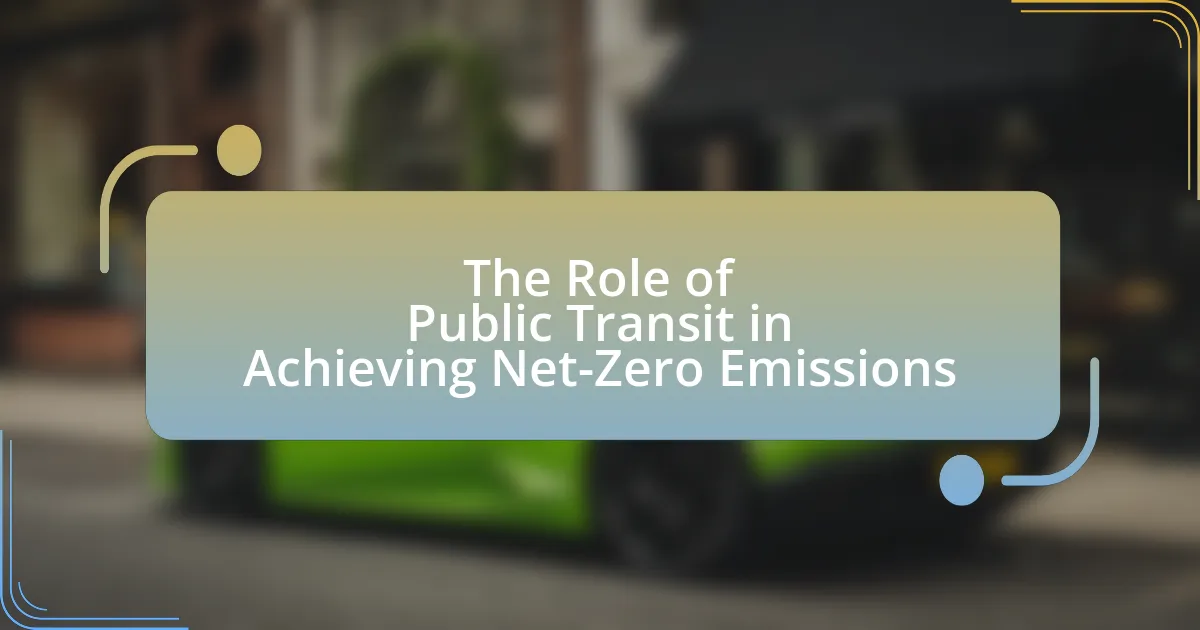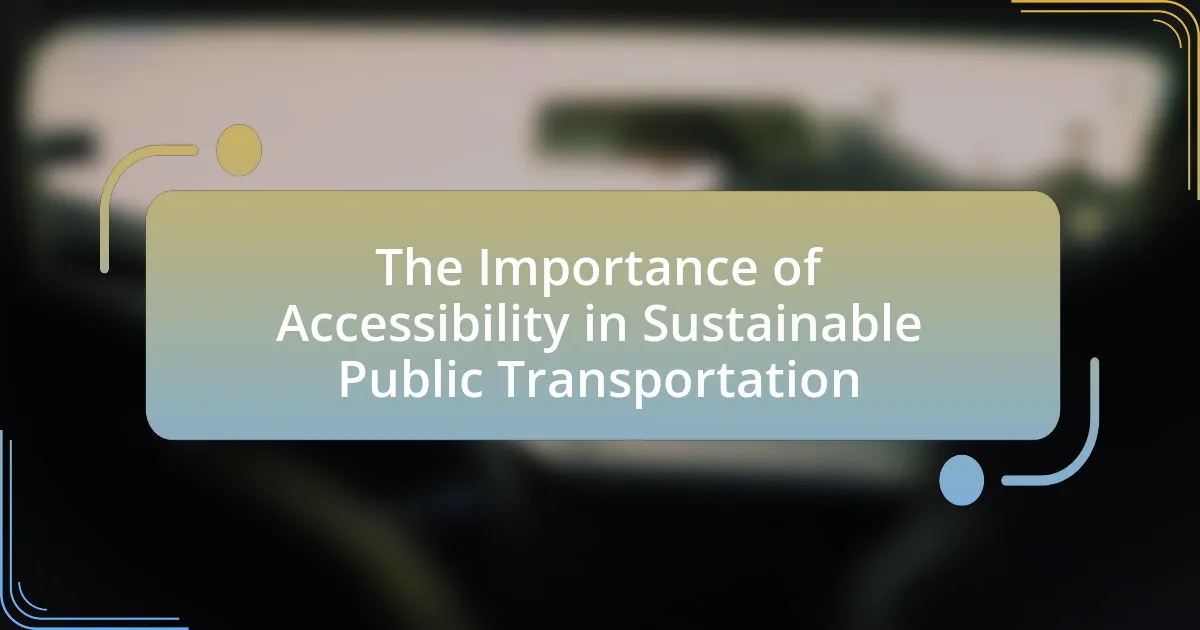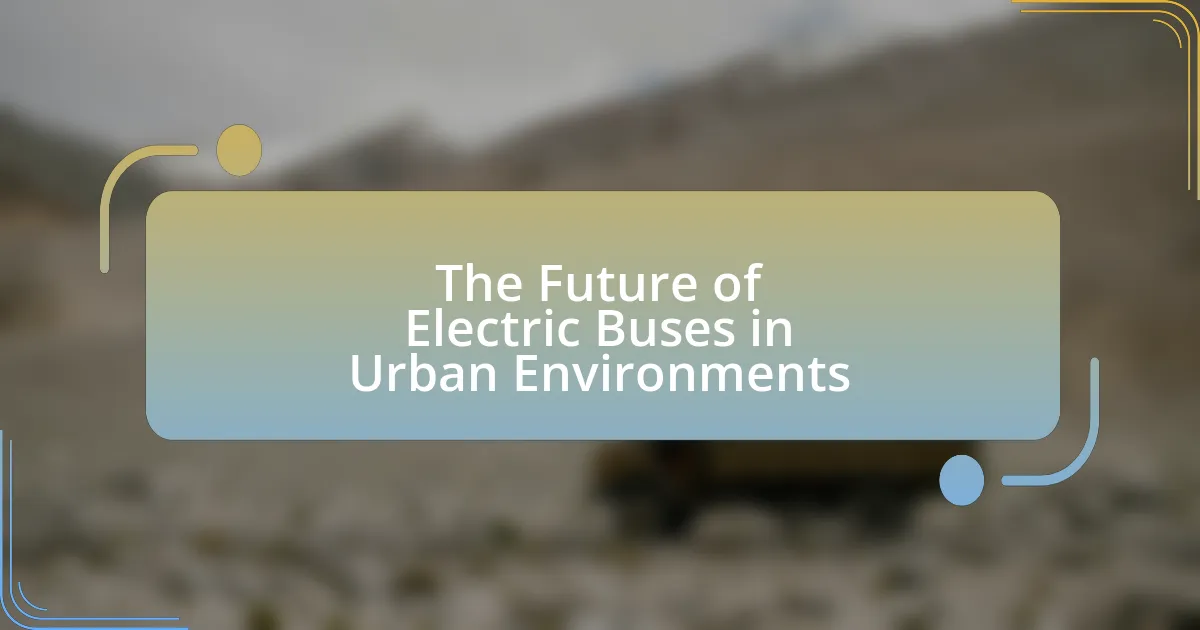The article evaluates the lifecycle emissions of electric versus diesel public transit vehicles, focusing on the total greenhouse gas emissions produced from manufacturing to disposal. It defines lifecycle emissions and explains how they are measured through Life Cycle Assessment (LCA), highlighting the differences in emissions across various stages, including manufacturing, operation, and end-of-life disposal. The article emphasizes the environmental impact of these emissions, the influence of renewable energy sources, and the role of government regulations in shaping public transit policies. Additionally, it discusses best practices for reducing emissions and optimizing vehicle fleets, ultimately advocating for the transition to electric vehicles as a more sustainable option in public transportation.
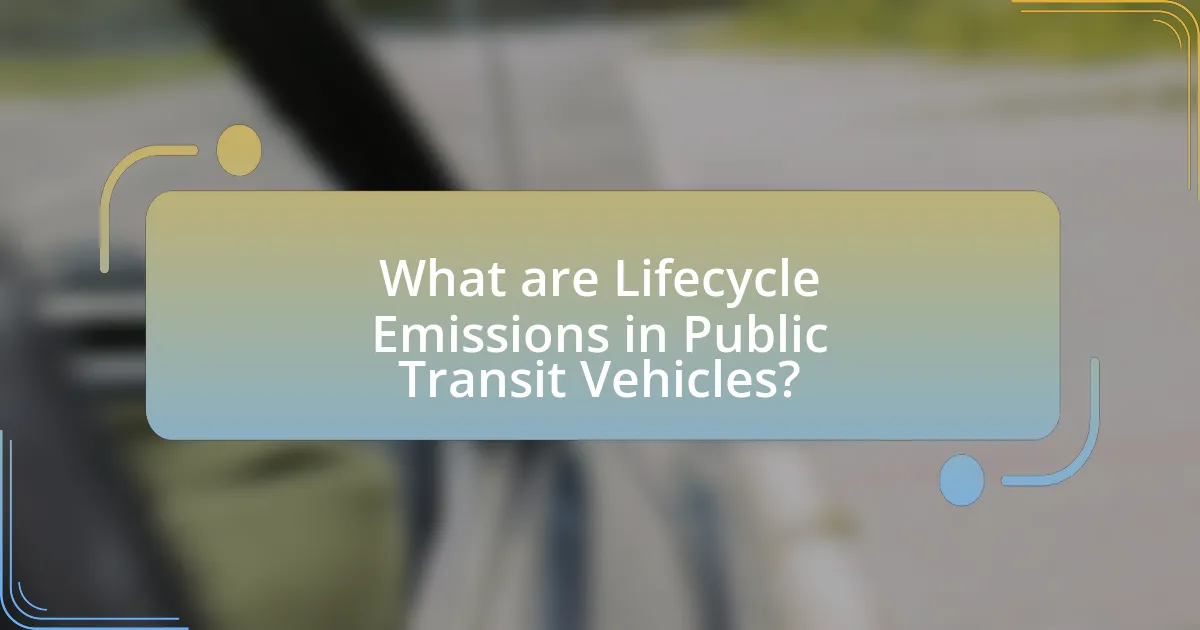
What are Lifecycle Emissions in Public Transit Vehicles?
Lifecycle emissions in public transit vehicles refer to the total greenhouse gas emissions produced throughout the entire lifespan of the vehicle, from manufacturing to disposal. This includes emissions generated during the production of materials, vehicle assembly, operation, maintenance, and end-of-life processes such as recycling or landfill disposal. For instance, studies indicate that electric buses typically have lower lifecycle emissions compared to diesel buses due to reduced operational emissions, despite the higher emissions associated with battery production. This comprehensive assessment is crucial for understanding the environmental impact of different transit vehicle types and informing policy decisions aimed at reducing overall emissions in public transportation systems.
How are lifecycle emissions defined and measured?
Lifecycle emissions are defined as the total greenhouse gas emissions associated with a product or service throughout its entire life cycle, from raw material extraction to disposal. These emissions are measured using a methodology called Life Cycle Assessment (LCA), which quantifies inputs and outputs at each stage, including production, transportation, use, and end-of-life disposal. LCA provides a comprehensive view of emissions by accounting for direct and indirect emissions, allowing for a comparison of different technologies, such as electric and diesel public transit vehicles. Studies have shown that LCA can reveal significant differences in lifecycle emissions, with electric vehicles often having lower emissions when accounting for the energy source used for electricity generation.
What stages are included in the lifecycle of a vehicle?
The lifecycle of a vehicle includes several key stages: raw material extraction, manufacturing, transportation, use, maintenance, and end-of-life disposal or recycling. Each stage contributes to the overall environmental impact of the vehicle. For instance, raw material extraction involves mining and processing materials like metals and plastics, which can generate significant emissions. Manufacturing encompasses the assembly of vehicle components, often resulting in high energy consumption. Transportation refers to the delivery of vehicles to dealerships, which also adds to emissions. The use phase is where fuel consumption occurs, significantly affecting emissions based on the vehicle type. Maintenance ensures the vehicle operates efficiently, while the end-of-life stage involves dismantling, recycling, or landfilling, impacting resource recovery and waste management.
How do emissions vary across different lifecycle stages?
Emissions vary significantly across different lifecycle stages of public transit vehicles, including manufacturing, operation, and end-of-life disposal. For electric vehicles, manufacturing typically results in higher emissions due to battery production, while operational emissions are lower compared to diesel vehicles, which emit greenhouse gases during operation. In contrast, diesel vehicles have lower manufacturing emissions but higher operational emissions, leading to a net increase in lifecycle emissions. Studies indicate that electric buses can reduce operational emissions by up to 70% compared to diesel buses, highlighting the importance of considering each lifecycle stage when evaluating overall emissions.
Why is it important to evaluate lifecycle emissions?
Evaluating lifecycle emissions is crucial because it provides a comprehensive understanding of the total environmental impact of a vehicle throughout its entire lifespan, from production to disposal. This assessment allows for informed decision-making regarding the sustainability of different transit options, such as electric versus diesel vehicles. For instance, studies have shown that electric vehicles can have significantly lower lifecycle emissions compared to diesel vehicles, particularly when powered by renewable energy sources. By quantifying emissions at each stage, stakeholders can identify opportunities for reducing carbon footprints and improving overall environmental performance in public transit systems.
What impact do emissions have on the environment?
Emissions significantly impact the environment by contributing to air pollution, climate change, and ecosystem degradation. Specifically, greenhouse gases such as carbon dioxide and methane trap heat in the atmosphere, leading to global warming, which has been documented to increase average global temperatures by approximately 1.1 degrees Celsius since the late 19th century. Additionally, particulate matter and nitrogen oxides from vehicle emissions can cause respiratory problems in humans and harm wildlife, as evidenced by studies showing that urban areas with high vehicle emissions experience increased rates of asthma and other health issues. Furthermore, emissions contribute to acid rain, which can damage forests and aquatic ecosystems, disrupting biodiversity and harming species.
How do lifecycle emissions influence public policy decisions?
Lifecycle emissions significantly influence public policy decisions by shaping regulations and funding priorities aimed at reducing environmental impacts. Policymakers assess the total emissions produced throughout a vehicle’s lifecycle, including manufacturing, operation, and disposal, to determine the most sustainable options for public transit. For instance, studies have shown that electric vehicles typically have lower lifecycle emissions compared to diesel vehicles, prompting governments to incentivize electric transit solutions through subsidies and infrastructure investments. This evidence-based approach aligns with global climate goals, as seen in initiatives like the European Union’s Green Deal, which aims to achieve net-zero emissions by 2050, thereby directly linking lifecycle emissions assessments to strategic policy frameworks.
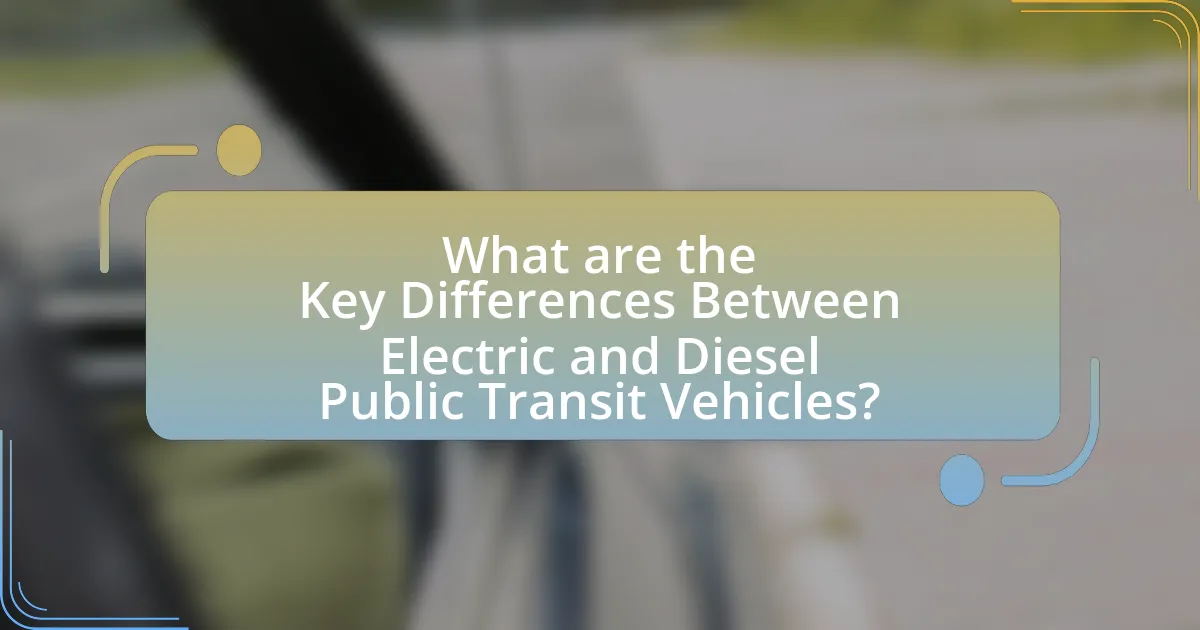
What are the Key Differences Between Electric and Diesel Public Transit Vehicles?
Electric public transit vehicles operate using electric power stored in batteries, while diesel public transit vehicles rely on internal combustion engines fueled by diesel. The key differences include emissions, with electric vehicles producing zero tailpipe emissions, contributing to improved air quality, whereas diesel vehicles emit greenhouse gases and pollutants, impacting environmental health. Additionally, electric vehicles generally have lower operational costs due to reduced fuel and maintenance expenses, while diesel vehicles often have higher fuel costs and require more frequent maintenance. Lifecycle assessments indicate that electric vehicles can significantly reduce overall emissions when considering the entire lifecycle, including manufacturing and energy sourcing, compared to diesel vehicles, which consistently show higher emissions throughout their lifecycle.
How do electric vehicles compare to diesel vehicles in terms of emissions?
Electric vehicles (EVs) produce significantly lower emissions compared to diesel vehicles. While diesel vehicles emit greenhouse gases and pollutants such as nitrogen oxides and particulate matter during operation, EVs generate zero tailpipe emissions. According to the U.S. Department of Energy, the lifecycle emissions of EVs can be up to 60% lower than those of diesel vehicles when considering the entire energy production process, including electricity generation. This reduction is particularly pronounced in regions where renewable energy sources are prevalent, further decreasing the overall carbon footprint associated with EVs.
What are the emissions produced during the manufacturing of each vehicle type?
The emissions produced during the manufacturing of electric vehicles (EVs) are significantly higher than those of diesel vehicles, primarily due to the production of lithium-ion batteries. Manufacturing an electric vehicle can generate approximately 150 to 200 kg of CO2 per kWh of battery capacity, leading to total emissions of around 60 to 100 tons of CO2 for a typical EV. In contrast, the manufacturing of a diesel vehicle typically results in emissions of about 10 to 20 tons of CO2. This difference is largely attributed to the energy-intensive processes involved in battery production, including mining and refining raw materials such as lithium, cobalt, and nickel.
How do operational emissions differ between electric and diesel vehicles?
Operational emissions from electric vehicles (EVs) are significantly lower than those from diesel vehicles. Diesel vehicles emit greenhouse gases and pollutants such as nitrogen oxides and particulate matter during operation, contributing to air quality issues and climate change. In contrast, electric vehicles produce zero tailpipe emissions, as they operate on electricity rather than fossil fuels.
According to the U.S. Department of Energy, the average electric vehicle emits about 4,000 pounds less CO2 per year compared to a diesel vehicle, assuming the electricity is generated from a mix of energy sources. This stark difference highlights the environmental benefits of electric vehicles in terms of operational emissions.
What are the advantages and disadvantages of each vehicle type?
Electric vehicles (EVs) offer advantages such as lower greenhouse gas emissions and reduced operational costs due to cheaper electricity compared to diesel fuel. Studies indicate that EVs can reduce lifecycle emissions by up to 70% compared to diesel vehicles, especially when charged with renewable energy sources. However, disadvantages include higher upfront costs and limited range, which can affect their practicality in certain transit scenarios.
Diesel vehicles, on the other hand, provide advantages like longer range and established refueling infrastructure, making them suitable for long-distance routes. They typically have lower initial purchase prices compared to EVs. Nonetheless, diesel vehicles are associated with higher lifecycle emissions, contributing significantly to air pollution and climate change, with emissions from diesel buses being approximately 10 times higher than those from electric buses over their lifetime.
What are the cost implications of electric versus diesel vehicles?
Electric vehicles generally have lower operating costs compared to diesel vehicles due to reduced fuel expenses and maintenance requirements. For instance, electricity costs for charging are typically lower than diesel fuel prices, with electric vehicles averaging around $0.03 to $0.05 per mile, while diesel vehicles can range from $0.10 to $0.15 per mile. Additionally, electric vehicles have fewer moving parts, leading to lower maintenance costs, estimated to be about 30% less than those of diesel vehicles.
Moreover, the total cost of ownership over a vehicle’s lifespan often favors electric vehicles, especially when considering government incentives and lower emissions-related fees. According to a study by the International Council on Clean Transportation, electric buses can save transit agencies up to $400,000 over their lifetime compared to diesel buses, primarily due to lower fuel and maintenance costs.
How do maintenance requirements differ for electric and diesel vehicles?
Electric vehicles (EVs) generally require less maintenance than diesel vehicles due to fewer moving parts and no need for oil changes. Diesel vehicles, on the other hand, have complex engines that require regular oil changes, fuel filter replacements, and exhaust system maintenance, including dealing with particulate filters. For instance, EVs do not have traditional transmissions or exhaust systems, which reduces the frequency of maintenance tasks. In contrast, diesel engines typically need maintenance every 5,000 to 10,000 miles, while EVs can often go 15,000 to 20,000 miles between services, highlighting the significant difference in maintenance intervals.
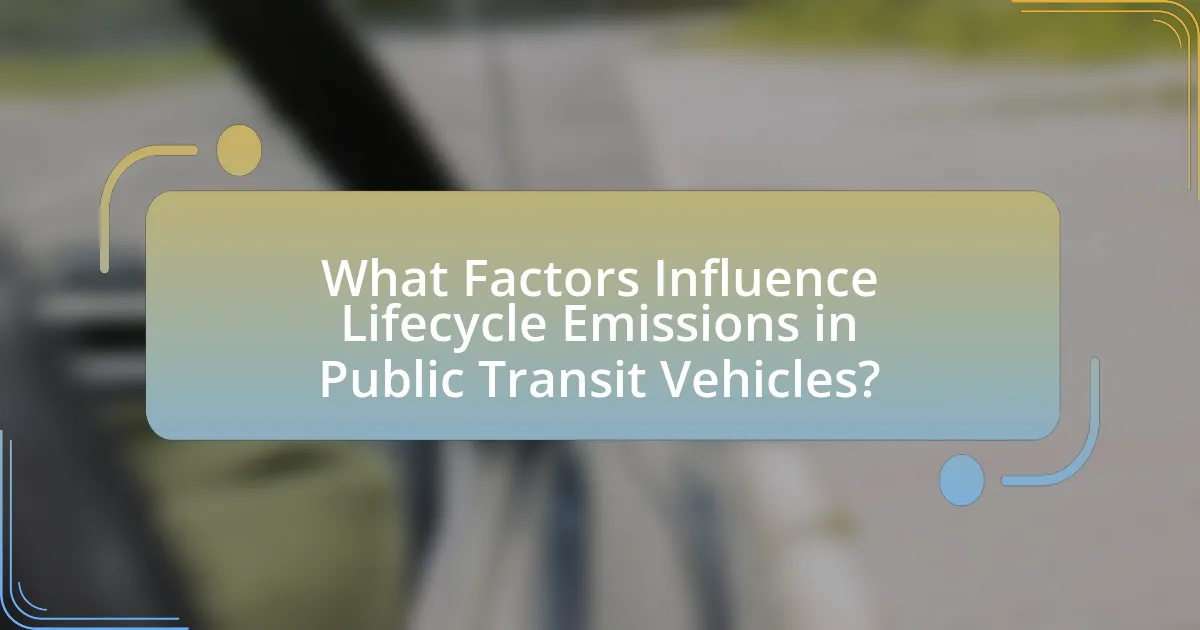
What Factors Influence Lifecycle Emissions in Public Transit Vehicles?
Lifecycle emissions in public transit vehicles are influenced by several key factors, including the type of fuel used, vehicle manufacturing processes, operational efficiency, and maintenance practices. The type of fuel, such as diesel or electricity, significantly impacts emissions; for instance, electric vehicles typically have lower operational emissions compared to diesel vehicles, but their lifecycle emissions depend on the source of electricity. Vehicle manufacturing processes contribute to emissions through the extraction of raw materials and production energy, with electric vehicles often requiring more energy-intensive battery production. Operational efficiency, which includes factors like vehicle design and route optimization, affects fuel consumption and emissions during use. Lastly, regular maintenance can enhance vehicle efficiency and reduce emissions over time. These factors collectively determine the overall environmental impact of public transit vehicles throughout their lifecycle.
How does the source of electricity affect electric vehicle emissions?
The source of electricity significantly affects electric vehicle emissions because the carbon intensity of the electricity generation directly influences the overall emissions associated with electric vehicles. For instance, if the electricity is generated from renewable sources like wind or solar, the emissions are substantially lower compared to electricity generated from fossil fuels such as coal or natural gas. According to the U.S. Environmental Protection Agency, electric vehicles charged with electricity from coal can produce emissions equivalent to gasoline vehicles, while those charged with renewable energy can result in zero tailpipe emissions and much lower lifecycle emissions. This demonstrates that the cleaner the electricity source, the lower the emissions associated with electric vehicle operation.
What role do renewable energy sources play in reducing emissions?
Renewable energy sources play a crucial role in reducing emissions by providing cleaner alternatives to fossil fuels. These sources, such as solar, wind, and hydroelectric power, generate electricity without releasing greenhouse gases during operation. For instance, according to the U.S. Energy Information Administration, in 2020, renewable energy sources accounted for about 20% of electricity generation in the United States, significantly lowering carbon dioxide emissions compared to traditional coal and natural gas power plants. By displacing fossil fuel use in public transit vehicles, renewable energy contributes to a substantial decrease in lifecycle emissions, making electric vehicles powered by renewables a more sustainable option than diesel alternatives.
How does the efficiency of the vehicle impact overall emissions?
The efficiency of a vehicle directly impacts overall emissions by determining the amount of fuel consumed and the corresponding greenhouse gases released. More efficient vehicles utilize less fuel for the same distance traveled, resulting in lower carbon dioxide emissions per mile. For instance, a study by the International Council on Clean Transportation found that electric buses produce significantly lower lifecycle emissions compared to diesel buses, primarily due to their higher energy efficiency and the cleaner energy sources used for electricity generation. This evidence illustrates that enhancing vehicle efficiency is crucial for reducing overall emissions in public transit systems.
What external factors can affect the lifecycle emissions of transit vehicles?
External factors that can affect the lifecycle emissions of transit vehicles include fuel type, energy source for electricity, vehicle maintenance practices, and operational conditions. The fuel type directly influences emissions, as diesel vehicles typically emit more greenhouse gases compared to electric vehicles powered by renewable energy sources. The energy source for electricity generation plays a crucial role; for instance, if electric vehicles are charged using coal-generated electricity, their lifecycle emissions can be significantly higher than those charged with renewable energy. Regular maintenance practices, such as tire pressure and engine tuning, can optimize fuel efficiency and reduce emissions. Additionally, operational conditions, including route design, traffic patterns, and passenger load, can impact the overall emissions profile of transit vehicles. These factors collectively determine the environmental impact of transit systems throughout their operational lifespan.
How do government regulations influence vehicle emissions?
Government regulations significantly influence vehicle emissions by establishing standards that limit the amount of pollutants vehicles can emit. For instance, the U.S. Environmental Protection Agency (EPA) sets National Ambient Air Quality Standards (NAAQS) that require manufacturers to reduce emissions of harmful substances like nitrogen oxides and particulate matter. These regulations compel automakers to innovate and adopt cleaner technologies, such as catalytic converters and electric powertrains, to comply with emission limits. As a result, vehicles produced under stringent regulations typically exhibit lower emissions, contributing to improved air quality and public health.
What is the impact of public transit infrastructure on emissions?
Public transit infrastructure significantly reduces emissions by promoting the use of mass transit over single-occupancy vehicles. Studies indicate that public transit systems can reduce greenhouse gas emissions by 45 million metric tons annually in the United States alone, as reported by the American Public Transportation Association. This reduction occurs because public transit vehicles, such as buses and trains, typically have lower emissions per passenger mile compared to personal vehicles, especially when powered by cleaner energy sources. Additionally, well-designed transit systems encourage higher ridership, further decreasing overall vehicle emissions in urban areas.
What are the best practices for reducing lifecycle emissions in public transit?
The best practices for reducing lifecycle emissions in public transit include transitioning to electric vehicles, optimizing routes for efficiency, implementing regenerative braking systems, and utilizing renewable energy sources for charging. Transitioning to electric vehicles significantly lowers emissions compared to diesel, as electric buses can reduce greenhouse gas emissions by up to 70% over their lifetime, depending on the energy source used for charging. Optimizing routes minimizes fuel consumption and emissions by reducing travel distances and times. Regenerative braking systems capture energy during braking, further enhancing efficiency. Finally, using renewable energy sources, such as solar or wind, for charging electric transit vehicles ensures that emissions are minimized throughout their operational lifecycle.
How can transit agencies optimize their vehicle fleets for lower emissions?
Transit agencies can optimize their vehicle fleets for lower emissions by transitioning to electric vehicles and implementing route optimization strategies. Electric vehicles produce zero tailpipe emissions, significantly reducing greenhouse gases compared to diesel counterparts, which emit approximately 22 pounds of CO2 per gallon of diesel burned. Additionally, optimizing routes through data analytics can minimize fuel consumption and reduce idle times, further lowering emissions. Studies indicate that agencies adopting electric fleets can achieve up to 70% reduction in lifecycle emissions compared to traditional diesel buses, highlighting the effectiveness of this approach.
What strategies can be implemented to promote the use of electric vehicles?
To promote the use of electric vehicles, governments and organizations can implement incentives such as tax rebates, grants, and subsidies for both consumers and manufacturers. These financial incentives encourage the purchase and production of electric vehicles, making them more accessible. For instance, countries like Norway have seen electric vehicle sales soar to over 54% of new car sales in 2020 due to such incentives. Additionally, expanding charging infrastructure is crucial; studies indicate that increased availability of charging stations significantly boosts electric vehicle adoption rates. Furthermore, public awareness campaigns highlighting the environmental benefits and cost savings of electric vehicles can shift consumer perceptions and increase demand.
